Demand and Supply Dynamics in the Australian Property Market Report
VerifiedAdded on 2020/03/03
|6
|1577
|21
Report
AI Summary
This report provides an in-depth analysis of the demand and supply dynamics within the Australian property market. It begins with an introduction referencing an article discussing the high demand and limited supply leading to property price increases. The analysis section delves into various factors influencing the market, including population growth, immigration, and foreign investment, while also considering the risks associated with the market's bubble. The report further examines the impact of low interest rates and the potential for a boom-bust cycle, referencing historical examples. It includes recommendations for policy reforms to prevent and mitigate the effects of a boom-bust cycle, such as reducing household debts and introducing incentives. The report concludes by emphasizing the importance of the property market to the Australian economy and the need for government intervention to avoid a market collapse. The report also includes a comprehensive bibliography of the sources used.
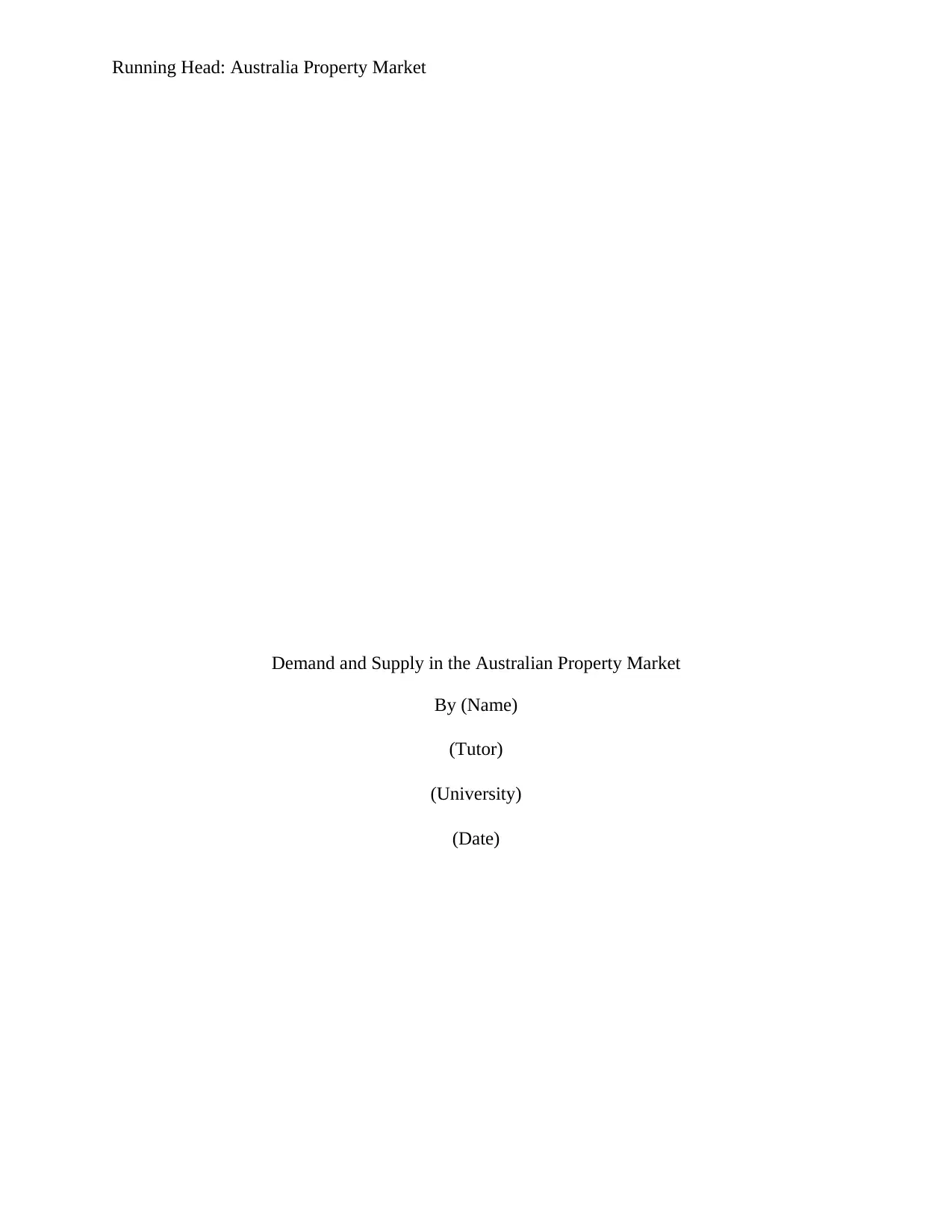
Running Head: Australia Property Market
Demand and Supply in the Australian Property Market
By (Name)
(Tutor)
(University)
(Date)
Demand and Supply in the Australian Property Market
By (Name)
(Tutor)
(University)
(Date)
Paraphrase This Document
Need a fresh take? Get an instant paraphrase of this document with our AI Paraphraser
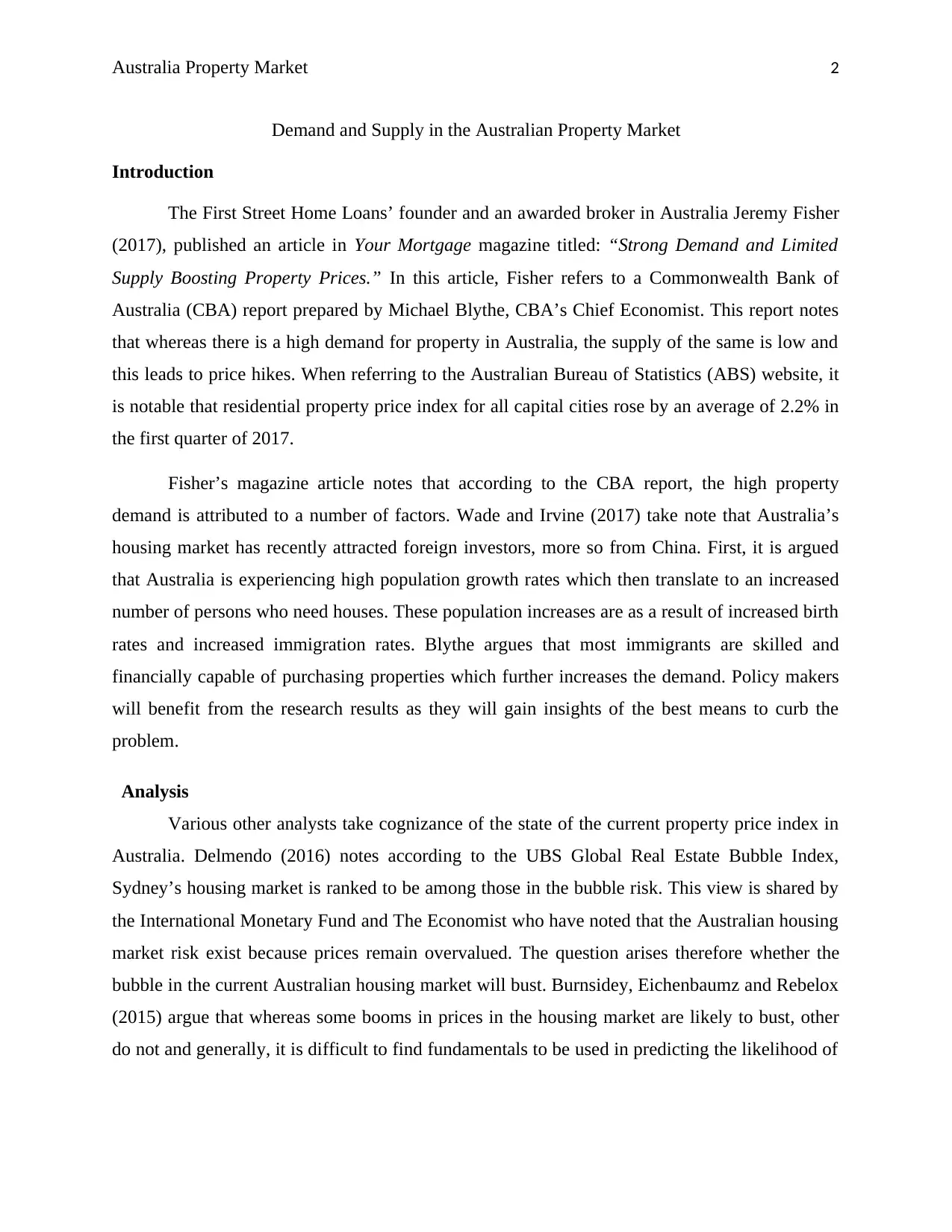
Australia Property Market 2
Demand and Supply in the Australian Property Market
Introduction
The First Street Home Loans’ founder and an awarded broker in Australia Jeremy Fisher
(2017), published an article in Your Mortgage magazine titled: “Strong Demand and Limited
Supply Boosting Property Prices.” In this article, Fisher refers to a Commonwealth Bank of
Australia (CBA) report prepared by Michael Blythe, CBA’s Chief Economist. This report notes
that whereas there is a high demand for property in Australia, the supply of the same is low and
this leads to price hikes. When referring to the Australian Bureau of Statistics (ABS) website, it
is notable that residential property price index for all capital cities rose by an average of 2.2% in
the first quarter of 2017.
Fisher’s magazine article notes that according to the CBA report, the high property
demand is attributed to a number of factors. Wade and Irvine (2017) take note that Australia’s
housing market has recently attracted foreign investors, more so from China. First, it is argued
that Australia is experiencing high population growth rates which then translate to an increased
number of persons who need houses. These population increases are as a result of increased birth
rates and increased immigration rates. Blythe argues that most immigrants are skilled and
financially capable of purchasing properties which further increases the demand. Policy makers
will benefit from the research results as they will gain insights of the best means to curb the
problem.
Analysis
Various other analysts take cognizance of the state of the current property price index in
Australia. Delmendo (2016) notes according to the UBS Global Real Estate Bubble Index,
Sydney’s housing market is ranked to be among those in the bubble risk. This view is shared by
the International Monetary Fund and The Economist who have noted that the Australian housing
market risk exist because prices remain overvalued. The question arises therefore whether the
bubble in the current Australian housing market will bust. Burnsidey, Eichenbaumz and Rebelox
(2015) argue that whereas some booms in prices in the housing market are likely to bust, other
do not and generally, it is difficult to find fundamentals to be used in predicting the likelihood of
Demand and Supply in the Australian Property Market
Introduction
The First Street Home Loans’ founder and an awarded broker in Australia Jeremy Fisher
(2017), published an article in Your Mortgage magazine titled: “Strong Demand and Limited
Supply Boosting Property Prices.” In this article, Fisher refers to a Commonwealth Bank of
Australia (CBA) report prepared by Michael Blythe, CBA’s Chief Economist. This report notes
that whereas there is a high demand for property in Australia, the supply of the same is low and
this leads to price hikes. When referring to the Australian Bureau of Statistics (ABS) website, it
is notable that residential property price index for all capital cities rose by an average of 2.2% in
the first quarter of 2017.
Fisher’s magazine article notes that according to the CBA report, the high property
demand is attributed to a number of factors. Wade and Irvine (2017) take note that Australia’s
housing market has recently attracted foreign investors, more so from China. First, it is argued
that Australia is experiencing high population growth rates which then translate to an increased
number of persons who need houses. These population increases are as a result of increased birth
rates and increased immigration rates. Blythe argues that most immigrants are skilled and
financially capable of purchasing properties which further increases the demand. Policy makers
will benefit from the research results as they will gain insights of the best means to curb the
problem.
Analysis
Various other analysts take cognizance of the state of the current property price index in
Australia. Delmendo (2016) notes according to the UBS Global Real Estate Bubble Index,
Sydney’s housing market is ranked to be among those in the bubble risk. This view is shared by
the International Monetary Fund and The Economist who have noted that the Australian housing
market risk exist because prices remain overvalued. The question arises therefore whether the
bubble in the current Australian housing market will bust. Burnsidey, Eichenbaumz and Rebelox
(2015) argue that whereas some booms in prices in the housing market are likely to bust, other
do not and generally, it is difficult to find fundamentals to be used in predicting the likelihood of
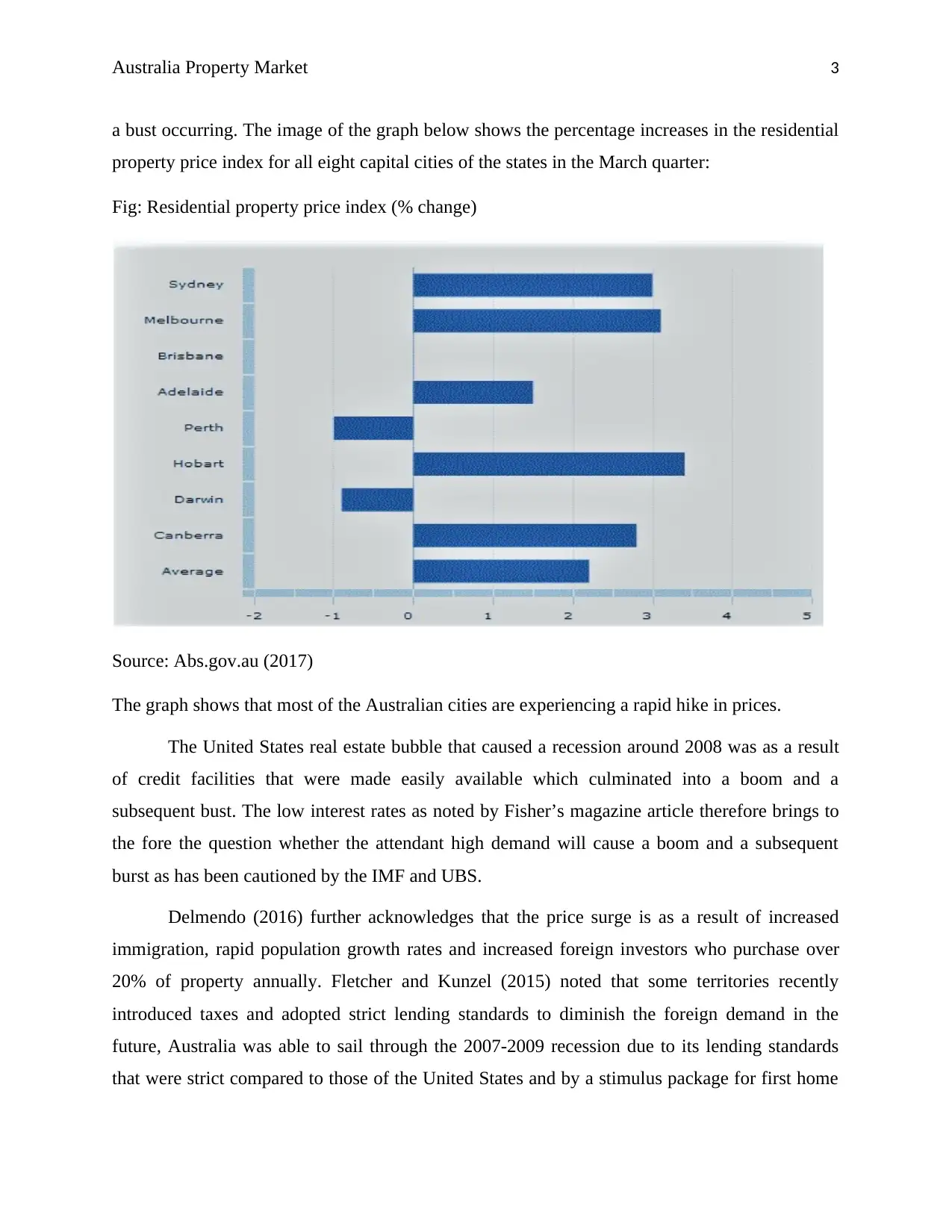
Australia Property Market 3
a bust occurring. The image of the graph below shows the percentage increases in the residential
property price index for all eight capital cities of the states in the March quarter:
Fig: Residential property price index (% change)
Source: Abs.gov.au (2017)
The graph shows that most of the Australian cities are experiencing a rapid hike in prices.
The United States real estate bubble that caused a recession around 2008 was as a result
of credit facilities that were made easily available which culminated into a boom and a
subsequent bust. The low interest rates as noted by Fisher’s magazine article therefore brings to
the fore the question whether the attendant high demand will cause a boom and a subsequent
burst as has been cautioned by the IMF and UBS.
Delmendo (2016) further acknowledges that the price surge is as a result of increased
immigration, rapid population growth rates and increased foreign investors who purchase over
20% of property annually. Fletcher and Kunzel (2015) noted that some territories recently
introduced taxes and adopted strict lending standards to diminish the foreign demand in the
future, Australia was able to sail through the 2007-2009 recession due to its lending standards
that were strict compared to those of the United States and by a stimulus package for first home
a bust occurring. The image of the graph below shows the percentage increases in the residential
property price index for all eight capital cities of the states in the March quarter:
Fig: Residential property price index (% change)
Source: Abs.gov.au (2017)
The graph shows that most of the Australian cities are experiencing a rapid hike in prices.
The United States real estate bubble that caused a recession around 2008 was as a result
of credit facilities that were made easily available which culminated into a boom and a
subsequent bust. The low interest rates as noted by Fisher’s magazine article therefore brings to
the fore the question whether the attendant high demand will cause a boom and a subsequent
burst as has been cautioned by the IMF and UBS.
Delmendo (2016) further acknowledges that the price surge is as a result of increased
immigration, rapid population growth rates and increased foreign investors who purchase over
20% of property annually. Fletcher and Kunzel (2015) noted that some territories recently
introduced taxes and adopted strict lending standards to diminish the foreign demand in the
future, Australia was able to sail through the 2007-2009 recession due to its lending standards
that were strict compared to those of the United States and by a stimulus package for first home
⊘ This is a preview!⊘
Do you want full access?
Subscribe today to unlock all pages.

Trusted by 1+ million students worldwide
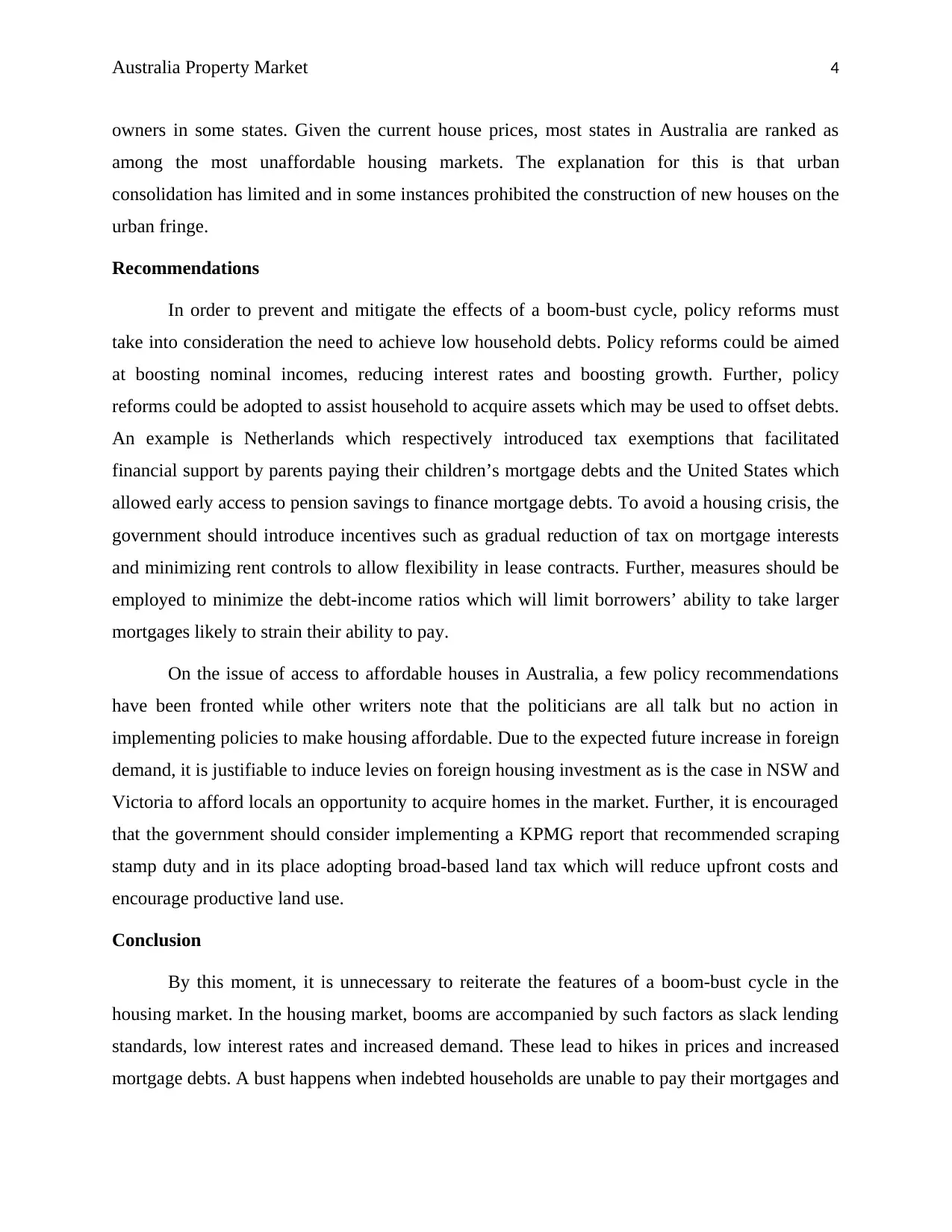
Australia Property Market 4
owners in some states. Given the current house prices, most states in Australia are ranked as
among the most unaffordable housing markets. The explanation for this is that urban
consolidation has limited and in some instances prohibited the construction of new houses on the
urban fringe.
Recommendations
In order to prevent and mitigate the effects of a boom-bust cycle, policy reforms must
take into consideration the need to achieve low household debts. Policy reforms could be aimed
at boosting nominal incomes, reducing interest rates and boosting growth. Further, policy
reforms could be adopted to assist household to acquire assets which may be used to offset debts.
An example is Netherlands which respectively introduced tax exemptions that facilitated
financial support by parents paying their children’s mortgage debts and the United States which
allowed early access to pension savings to finance mortgage debts. To avoid a housing crisis, the
government should introduce incentives such as gradual reduction of tax on mortgage interests
and minimizing rent controls to allow flexibility in lease contracts. Further, measures should be
employed to minimize the debt-income ratios which will limit borrowers’ ability to take larger
mortgages likely to strain their ability to pay.
On the issue of access to affordable houses in Australia, a few policy recommendations
have been fronted while other writers note that the politicians are all talk but no action in
implementing policies to make housing affordable. Due to the expected future increase in foreign
demand, it is justifiable to induce levies on foreign housing investment as is the case in NSW and
Victoria to afford locals an opportunity to acquire homes in the market. Further, it is encouraged
that the government should consider implementing a KPMG report that recommended scraping
stamp duty and in its place adopting broad-based land tax which will reduce upfront costs and
encourage productive land use.
Conclusion
By this moment, it is unnecessary to reiterate the features of a boom-bust cycle in the
housing market. In the housing market, booms are accompanied by such factors as slack lending
standards, low interest rates and increased demand. These lead to hikes in prices and increased
mortgage debts. A bust happens when indebted households are unable to pay their mortgages and
owners in some states. Given the current house prices, most states in Australia are ranked as
among the most unaffordable housing markets. The explanation for this is that urban
consolidation has limited and in some instances prohibited the construction of new houses on the
urban fringe.
Recommendations
In order to prevent and mitigate the effects of a boom-bust cycle, policy reforms must
take into consideration the need to achieve low household debts. Policy reforms could be aimed
at boosting nominal incomes, reducing interest rates and boosting growth. Further, policy
reforms could be adopted to assist household to acquire assets which may be used to offset debts.
An example is Netherlands which respectively introduced tax exemptions that facilitated
financial support by parents paying their children’s mortgage debts and the United States which
allowed early access to pension savings to finance mortgage debts. To avoid a housing crisis, the
government should introduce incentives such as gradual reduction of tax on mortgage interests
and minimizing rent controls to allow flexibility in lease contracts. Further, measures should be
employed to minimize the debt-income ratios which will limit borrowers’ ability to take larger
mortgages likely to strain their ability to pay.
On the issue of access to affordable houses in Australia, a few policy recommendations
have been fronted while other writers note that the politicians are all talk but no action in
implementing policies to make housing affordable. Due to the expected future increase in foreign
demand, it is justifiable to induce levies on foreign housing investment as is the case in NSW and
Victoria to afford locals an opportunity to acquire homes in the market. Further, it is encouraged
that the government should consider implementing a KPMG report that recommended scraping
stamp duty and in its place adopting broad-based land tax which will reduce upfront costs and
encourage productive land use.
Conclusion
By this moment, it is unnecessary to reiterate the features of a boom-bust cycle in the
housing market. In the housing market, booms are accompanied by such factors as slack lending
standards, low interest rates and increased demand. These lead to hikes in prices and increased
mortgage debts. A bust happens when indebted households are unable to pay their mortgages and
Paraphrase This Document
Need a fresh take? Get an instant paraphrase of this document with our AI Paraphraser
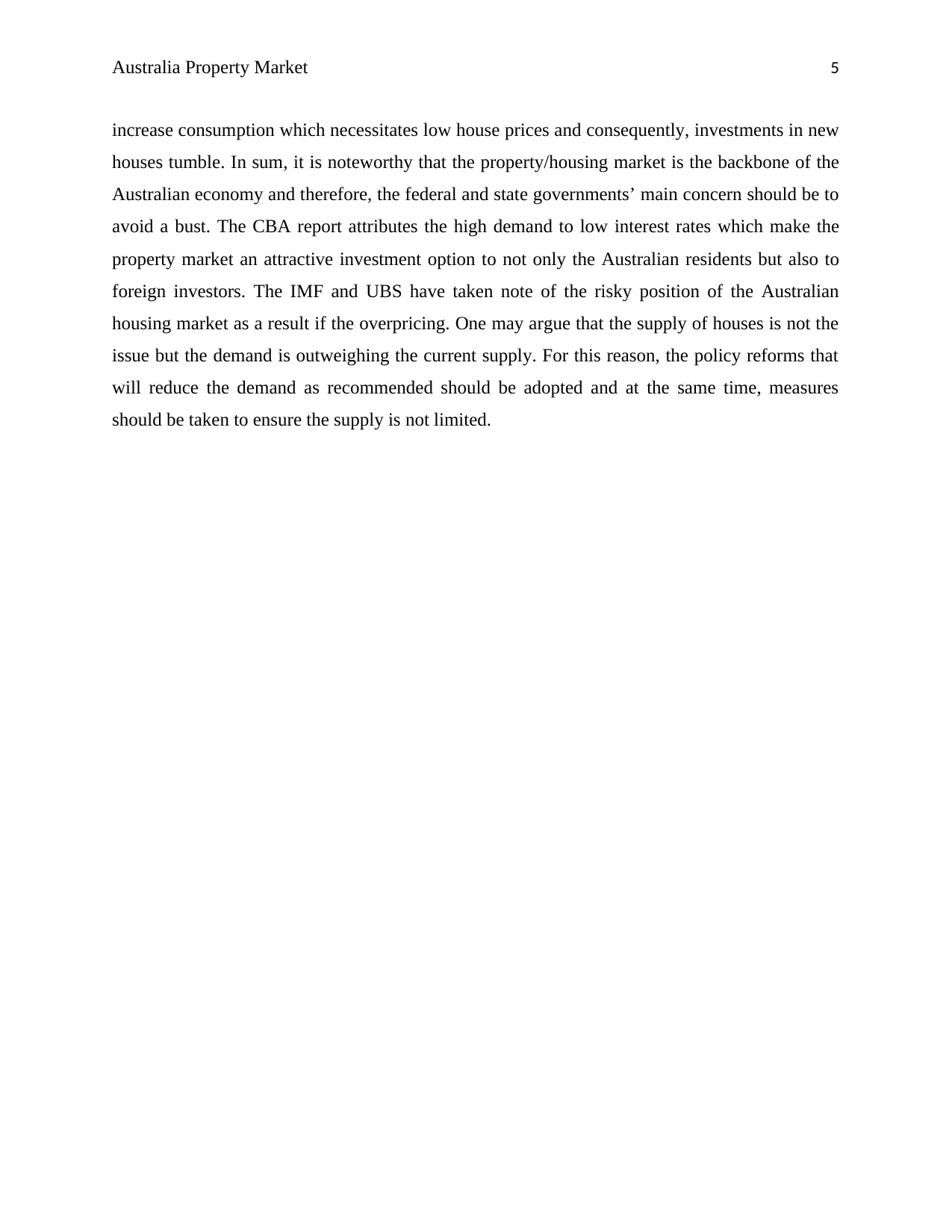
Australia Property Market 5
increase consumption which necessitates low house prices and consequently, investments in new
houses tumble. In sum, it is noteworthy that the property/housing market is the backbone of the
Australian economy and therefore, the federal and state governments’ main concern should be to
avoid a bust. The CBA report attributes the high demand to low interest rates which make the
property market an attractive investment option to not only the Australian residents but also to
foreign investors. The IMF and UBS have taken note of the risky position of the Australian
housing market as a result if the overpricing. One may argue that the supply of houses is not the
issue but the demand is outweighing the current supply. For this reason, the policy reforms that
will reduce the demand as recommended should be adopted and at the same time, measures
should be taken to ensure the supply is not limited.
increase consumption which necessitates low house prices and consequently, investments in new
houses tumble. In sum, it is noteworthy that the property/housing market is the backbone of the
Australian economy and therefore, the federal and state governments’ main concern should be to
avoid a bust. The CBA report attributes the high demand to low interest rates which make the
property market an attractive investment option to not only the Australian residents but also to
foreign investors. The IMF and UBS have taken note of the risky position of the Australian
housing market as a result if the overpricing. One may argue that the supply of houses is not the
issue but the demand is outweighing the current supply. For this reason, the policy reforms that
will reduce the demand as recommended should be adopted and at the same time, measures
should be taken to ensure the supply is not limited.
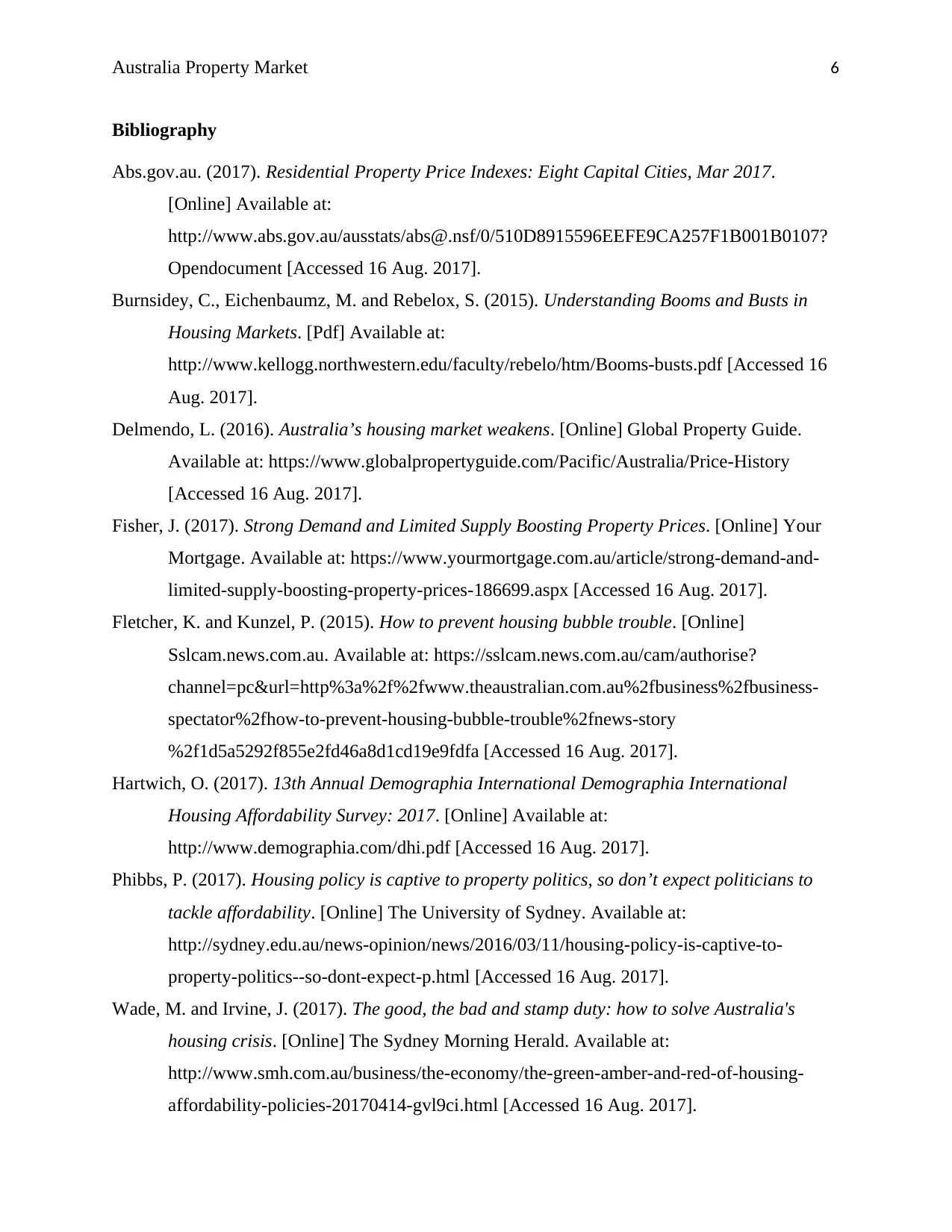
Australia Property Market 6
Bibliography
Abs.gov.au. (2017). Residential Property Price Indexes: Eight Capital Cities, Mar 2017.
[Online] Available at:
http://www.abs.gov.au/ausstats/abs@.nsf/0/510D8915596EEFE9CA257F1B001B0107?
Opendocument [Accessed 16 Aug. 2017].
Burnsidey, C., Eichenbaumz, M. and Rebelox, S. (2015). Understanding Booms and Busts in
Housing Markets. [Pdf] Available at:
http://www.kellogg.northwestern.edu/faculty/rebelo/htm/Booms-busts.pdf [Accessed 16
Aug. 2017].
Delmendo, L. (2016). Australia’s housing market weakens. [Online] Global Property Guide.
Available at: https://www.globalpropertyguide.com/Pacific/Australia/Price-History
[Accessed 16 Aug. 2017].
Fisher, J. (2017). Strong Demand and Limited Supply Boosting Property Prices. [Online] Your
Mortgage. Available at: https://www.yourmortgage.com.au/article/strong-demand-and-
limited-supply-boosting-property-prices-186699.aspx [Accessed 16 Aug. 2017].
Fletcher, K. and Kunzel, P. (2015). How to prevent housing bubble trouble. [Online]
Sslcam.news.com.au. Available at: https://sslcam.news.com.au/cam/authorise?
channel=pc&url=http%3a%2f%2fwww.theaustralian.com.au%2fbusiness%2fbusiness-
spectator%2fhow-to-prevent-housing-bubble-trouble%2fnews-story
%2f1d5a5292f855e2fd46a8d1cd19e9fdfa [Accessed 16 Aug. 2017].
Hartwich, O. (2017). 13th Annual Demographia International Demographia International
Housing Affordability Survey: 2017. [Online] Available at:
http://www.demographia.com/dhi.pdf [Accessed 16 Aug. 2017].
Phibbs, P. (2017). Housing policy is captive to property politics, so don’t expect politicians to
tackle affordability. [Online] The University of Sydney. Available at:
http://sydney.edu.au/news-opinion/news/2016/03/11/housing-policy-is-captive-to-
property-politics--so-dont-expect-p.html [Accessed 16 Aug. 2017].
Wade, M. and Irvine, J. (2017). The good, the bad and stamp duty: how to solve Australia's
housing crisis. [Online] The Sydney Morning Herald. Available at:
http://www.smh.com.au/business/the-economy/the-green-amber-and-red-of-housing-
affordability-policies-20170414-gvl9ci.html [Accessed 16 Aug. 2017].
Bibliography
Abs.gov.au. (2017). Residential Property Price Indexes: Eight Capital Cities, Mar 2017.
[Online] Available at:
http://www.abs.gov.au/ausstats/abs@.nsf/0/510D8915596EEFE9CA257F1B001B0107?
Opendocument [Accessed 16 Aug. 2017].
Burnsidey, C., Eichenbaumz, M. and Rebelox, S. (2015). Understanding Booms and Busts in
Housing Markets. [Pdf] Available at:
http://www.kellogg.northwestern.edu/faculty/rebelo/htm/Booms-busts.pdf [Accessed 16
Aug. 2017].
Delmendo, L. (2016). Australia’s housing market weakens. [Online] Global Property Guide.
Available at: https://www.globalpropertyguide.com/Pacific/Australia/Price-History
[Accessed 16 Aug. 2017].
Fisher, J. (2017). Strong Demand and Limited Supply Boosting Property Prices. [Online] Your
Mortgage. Available at: https://www.yourmortgage.com.au/article/strong-demand-and-
limited-supply-boosting-property-prices-186699.aspx [Accessed 16 Aug. 2017].
Fletcher, K. and Kunzel, P. (2015). How to prevent housing bubble trouble. [Online]
Sslcam.news.com.au. Available at: https://sslcam.news.com.au/cam/authorise?
channel=pc&url=http%3a%2f%2fwww.theaustralian.com.au%2fbusiness%2fbusiness-
spectator%2fhow-to-prevent-housing-bubble-trouble%2fnews-story
%2f1d5a5292f855e2fd46a8d1cd19e9fdfa [Accessed 16 Aug. 2017].
Hartwich, O. (2017). 13th Annual Demographia International Demographia International
Housing Affordability Survey: 2017. [Online] Available at:
http://www.demographia.com/dhi.pdf [Accessed 16 Aug. 2017].
Phibbs, P. (2017). Housing policy is captive to property politics, so don’t expect politicians to
tackle affordability. [Online] The University of Sydney. Available at:
http://sydney.edu.au/news-opinion/news/2016/03/11/housing-policy-is-captive-to-
property-politics--so-dont-expect-p.html [Accessed 16 Aug. 2017].
Wade, M. and Irvine, J. (2017). The good, the bad and stamp duty: how to solve Australia's
housing crisis. [Online] The Sydney Morning Herald. Available at:
http://www.smh.com.au/business/the-economy/the-green-amber-and-red-of-housing-
affordability-policies-20170414-gvl9ci.html [Accessed 16 Aug. 2017].
⊘ This is a preview!⊘
Do you want full access?
Subscribe today to unlock all pages.

Trusted by 1+ million students worldwide
1 out of 6
Related Documents
Your All-in-One AI-Powered Toolkit for Academic Success.
+13062052269
info@desklib.com
Available 24*7 on WhatsApp / Email
![[object Object]](/_next/static/media/star-bottom.7253800d.svg)
Unlock your academic potential
Copyright © 2020–2025 A2Z Services. All Rights Reserved. Developed and managed by ZUCOL.





